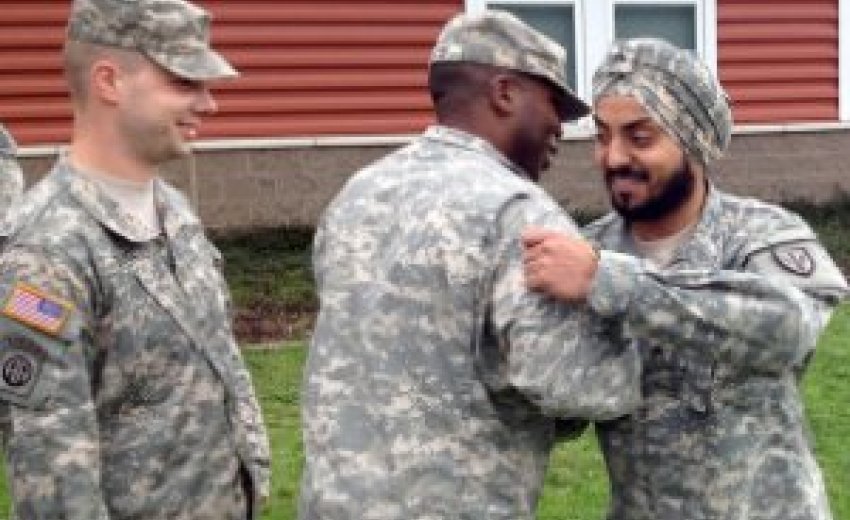| Cpl. Simranpreet Lamba receives congratulations at his promotion ceremony on Joint Base Lewis-McChord Friday, Sept. 27. 2013.ADAM ASHTON — Staff writer |
Simranpreet Lamba stands out when he lines up with his fellow soldiers in his Joint Base Lewis-McChord cavalry troop. He’s the bearded one wearing the camouflage turban.
As the Army’s only enlisted Sikh soldier, Lamba, 29, feels the pressure to prove himself so others of his faith can put on a uniform and serve their country. He took a step toward that goal Friday when the Army promoted him to corporal, making him the first Sikh to earn that rank in more than 30 years.
“I kind of think all my hard work has paid off,” said Lamba, whose enlistment in 2009 triggered a 10-month review in which Army officials considered whether he could serve while sporting the articles of his faith — a turban, uncut hair and a beard.
He’s one of a handful of Sikhs serving in the Army across the active-duty and Reserve forces, according to the New York-based Sikh Coalition. Two of the others are in the medical field as officers, one a dentist and one a doctor.
Each current Sikh soldier had to gain an exemption allowing him to serve despite Army policies dating back to 1984 that require soldiers to shave, keep short hair and wear standard berets. Those rules prevented Sikhs from enlisting for decades.
They hail from a 500-year-old religion with roots in India’s Punjab Region. About 200,000 to 500,000 Sikhs live in the U.S., according to estimates from the Pew Research Center.
Lamba hopes his promotion will show “there’s nothing about being Sikh, about our turban and our beard that can stop us from excelling in the Army,” he said.
He enlisted through a military program that recruits foreigners with special skills and offers them a path to citizenship. Lamba, who has become a naturalized U.S. citizen, speaks Urdu, Hindi and Punjabi — languages vital to communication with the people of India and Pakistan.
He adapted his faith to his military service with a little creativity. He fashioned his camouflage turban by buying a sheet of cloth and cutting it to fit his needs. A Velcro patch on the front shows his rank, similar to how Army caps appear.
He has another turban that fits under his combat helmet, and he has found a way to firmly fix a gas mask to his face by applying petroleum jelly to his beard.
He moved to America from New Delhi in 2006 and found his way to the Army after he earned a master’s degree in industrial engineering from New York University.
He said he always wanted to serve his country in uniform. Enlisting let him fulfill that dream.
His promotion from specialist to corporal was a lateral move, but it signifies that he’s doing well and is on a path to becoming a sergeant. He’d be the first Sikh sergeant in decades if he earned that rank.
“Every time he gets promoted, he’s going to be a first,” said his commanding officer, Capt. Craig Morehead.
Lamba’s hitting his stride as a medic in the 3rd Squadron, 38th Cavalry Regiment at Lewis-McChord. It’s part of the base’s intelligence-gathering 201st Battlefield Surveillance Brigade.
“He’s very driven in everything he does,” said Sgt. 1st Class Edgar Baeza. “He’s always asking for more responsibilities.”
Baeza heard about Lamba before they met. The Sikh soldier has been featured in stories published by The New York Times, The Associated Press and Army Times.
“I was pretty excited when I found out he was going to be in my unit,” Baeza said. Lamba “has taught us a lot about his culture and upbringing.”
Lamba and his wife, Guneet, live in University Place. She notices he often brings his work home with him.
“He’s really a very hard worker,” she said. At bedtime, he’s always talking about what he needs to accomplish the next day, she said.
Lamba received a line of handshakes and hugs from his fellow soldiers after he received his new rank.
“I really look forward to a long career in the Army,” he told them.

